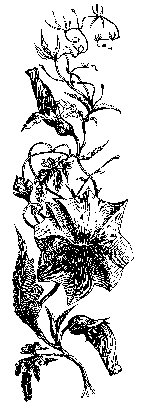


is for Grandma’s Magic Healing Salve–
The basic technique for making salves, ointments, or unguents is discussed in “The Kitchen Apothecary” section beginning on page 3. However, since I have mentioned this very special concoction a few times throughout the book, I thought I would give it the place it deserves amongst the Home Remedies Hall of Fame. Grandma’s magic healing salve is renowned for taking the ouch out of owies, putting the supple back into scabs, and returning the moisture into lips chapped by a week of steady wind across the phenomenal high desert of southern Oregon. Aw, heck—you can practically eat the stuff, it really is magic.
Get Personal
Really, I believe in this stuff so much that I create a ceremony for the harvesting of the herbs and the gathering of all the ingredients and equipment used to make the salve. In northern Idaho, this usually happens sometime in early June, when everything is up and reaching toward the sun. I gather the leaves and flowers of several plants and simmer them ever so gently in pure olive oil, strain the oil, and harden it with grated beeswax. It’s very easy to make, and it is a good way to introduce young ones to the healing powers of common herbs and wild plants. They will also enjoy their own personal plant ceremony, should you choose to create one.
Be Positive
You will, of course, be able to make a positive identification of each plant you use, and show this to the children by cross-referencing with a well-illustrated field guide. My main rule with kids is that they should never eat anything without showing me first, preferably while the plant is still rooted and growing. Then I show them specific ways to identify the plant, show them a similar plant and how to distinguish the differences, and test them on it later. Most kids I’ve met have no problem eating and finding “wild food,” or even harvesting herbs from the garden; it gives them a sense of purpose and satisfaction, and a knowledge that won’t fade if we encourage their learning. When making grandma’s magic healing salve, it’s easy to appreciate a useful, aromatic concoction that is soothing to everyday scrapes and bruises and chapped lips, even if it is green (but it doesn’t look green on your lips, I promise).
They’re Really More like Guidelines
Here is a basic recipe for salve using a one-quart mini slow cooker, so you can get an idea of quantities needed for each ingredient. If you use a saucepan, just be sure to keep the heat at a bare simmer; you want to extract the healing compounds from the herbs, not cook them. Choose at least three different herbs from the list on page 148.
As is mentioned in “The Kitchen Apothecary,” I like to use a mini slow cooker to infuse herbs in the oil. It’s the perfect non-scorching type of heat, and the amount of herbs you can fit in it is enough to handle without concern for heaviness or gallons of warm green oil. If you don’t want to use a slow cooker, just use a stainless steel or enameled saucepan and keep the heat low, way low (this method takes less time than the slow cooker).
How do you know when the oil is finished infusing? Start by looking at the color. It should be turning dark green, and the plant material itself should have lost some of its own green color. Some references say to cook the leaves until crisp, but I don’t do it that way as it’s almost burnt by that time and not as desirable, in my opinion.

Grandma’s Magic Healing Salve
3 cups chopped, shredded, or torn herb leaves or flowers
3 cups olive or almond oil (you may need a bit more to cover the herbs)
1–2 ounces grated beeswax
Combine the herbs and oil in slow cooker (or saucepan) and set it to low heat, uncovered, for 12 hours or overnight, stirring occasionally; add more oil if necessary to keep the herbs covered. When oil is colored dark green from the herbs, line a strainer with cheesecloth or some other material, set it into an appropriately sized saucepan, and pour the oil extract through the cloth and into the second pan. Squeeze as much oil out of the plant-stuff as possible before discarding it (it’s too oily for the compost). Put the oil extract over low heat and add the grated beeswax, about 1 ounce wax to a pint of oil, and stir. You will have to experiment with the amount of wax, which is another good reason not to make too much at a time. Once the wax is fully dissolved, put a small spoonful of the oil-wax mixture onto a plate and wait for it to cool, then check for hardness. If it is to your liking, then carefully pour the oil blend into small shallow jars, lip balm pots, or what have you. Half-pint and quarter-pint wide-mouth canning jars are very practical for this purpose and easy to come by. The salve will shrink a bit as it cools, also becoming lighter in color. Do not cover until cool, and do not disturb the jars while cooling. If you are going to use this herbal oil for both salve and lip balm, pour some of the waxed oil into the larger jars first for salve, then take the rest and return to low heat to add a touch more wax to make the lip balm a little harder consistency. This salve is perfectly safe for dogs, cats, horses, and other farm animals in addition to humans. Grandma’s magic healing salve makes a very nice gift. Makes approximately 3 cups.
Leaf and Flower
The following list is just that, a list. It does, however, reflect my personal priorities in what I like the most of in my salve, starting at the top. I will not tell you how much to use—that partly depends on what grows in your vicinity and the size of your simmering vessel. This is my usual list; you will create your own, and it will be just as magical.
• comfrey leaf
• heal-all (also known as self-heal) leaf and flower
• plantain leaf
• chickweed
• yarrow leaf and flower
• cedar leaves
• St. John’s wort, flowering tops
• violet leaf
• rose petals
• mint leaves
• elderberry leaf
• sage leaves
• lavender leaves
• clover blossoms
• thyme sprigs
• rosemary leaf
• cinquefoil leaf
You will note that many of the culinary herbs, such as thyme, sage, and rosemary, have antiseptic properties and would be appropriate in this salve. Some people like to add cottonwood buds that they picked in late winter and kept in the freezer until now. We want the salve to be emollient as well, to lubricate and quench stressed skin, so flower petals and tender leaves such as chickweed and heal-all are part of the equation. I’ve even made purely flower petal salves, and they are fragrant and beautiful. I call it fairy flower butter, and it makes an exquisite lip balm. You can use rose petals, clover blossoms, calendula petals, monarda petals, lemon balm flowers, dandelion petals, hollyhocks, violets, and so on. This could be fun for an all-girl sleep-over—picking flowers in the afternoon and making the balm, the next day everyone taking some home.
Learn what healing plants grow where you live. These are the plants that grow where I live. Just be sure to properly identify, and you will be safe.
Who’s Your Granny?
And that, too, is part of the magic—being a grandma, that is. It is a privilege and honor to be looked up to for guidance and comfort. At least it is for me. That, and a whole new generation I can get to listen to the Beatles!